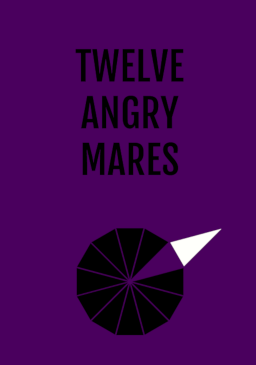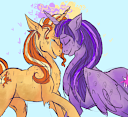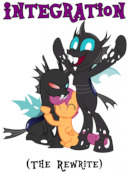Deliberately the forepony stood, went to the door, and rapped twice. She exchanged a few words with the bailiff, then stepped out. Behind her came Twelve, a grave look on her face, and Seven, eager to get out by any means necessary.
One at a time they left. Nine tottered to her hooves, exiting under her own power. Five hurried, glad to leave the room and all those in it. Behind her came Four, even-tempered and purposeful, not a hair out of place in her mane, despite the humidity, the rain, the past deliberations.
Two came next, glad the process was over and somewhat looking forward to what came after. Six grabbed her jacket and clapped Two on the back. Ten slipped out past them, her face a mask of displeasure, but what the mask hid nopony could tell. Eleven followed, her coat standing out from the others almost as much as her jacket did.
Three remained at the table, head tucked away in an elbow, her body still.
Eight waited until the others had left before going for her own coat, a plain purple affair. After a moment’s hesitation she took the only coat left hanging, slowly walking it over to the table. She offered it, and Three accepted wordlessly.
Slowly, the older earth pony got to her feet, somewhat unsteady but not above accepting assistance. Eight helped her into the jacket, one arm at a time. For now, the rain beat steady, giving no sign of letting up, but it didn’t have to. That too would pass.
Three stumbled off, and as Eight followed her out the door she took one last look back at the room. It felt small, small and crowded as ever, even when empty. The fan still hummed to itself, the windows still quivered with the rain, but what was done was done. She turned and left.
In the room there was a table, and on that table there was the detritus of twelve angry mares. And at the end of it there stood a dagger, its hilt green and black, its point sunk into the table. And next to the dagger lay a little slip of paper, its ragged edges framing two words in gently flowing script: not guilty.
And outside the courthouse, life went on.
Author's Note: I don’t usually do author’s notes. I generally believe that a work should stand or fall on its own, and that author’s notes are either irrelevant in the long run (a quick “next chapter coming in a week!” makes no sense two years later) or should be within the main story itself.
And yet, here I am, with too many thoughts to stuff into the story description yet too few to let slip by entirely.
Twelve Angry Mares is, as one might suspect from the title, a fairly straight adaptation of Twelve Angry Men, the 1954 screenplay by Reginald Rose, perhaps best known for its 1957 film incarnation starring Henry Fonda. The present adaptation draws heavily from the film, but is also influenced by the original screenplay’s presentation and act structure. And, of course, there are some things that are just different.
Chief among the differences is that Twelve Angry Men is, for all its dramatic structure, no longer an accurate reflection of the American legal system, if indeed it ever was. To offer one prominent example, while much of the drama in Twelve Angry Men is premised on the jurors’ knowledge that a guilty verdict means the death penalty, that’s not quite how things work: in almost all circumstances, the jury cannot know the possible sentencing range, and even informing the jury of a potential sentence may be grounds for a mistrial.
I have changed a few things here and there to bring Twelve Angry Mares in line with the legal system as it currently stands, but at the end of the day I’ve had to let a lot go. Describing the differences between Twelve Angry Men and the contemporary criminal trial process is not a new exercise, and I will not bore you with repeating it here.
I will, however, note that modern juries are given extensive instruction on what they must do; many states have standardized jury instructions, pre-determined forms that provide the appropriate amount of information so that no jury works in the blind. The value of these instructions is a subject of not insignificant scholarly debate, but they exist. Obviously, what the jury does with their instructions is another question entirely, but no jury would ever go into deliberations ‘blind.’ The core story told, this tug-of-war between logic and prejudice, is replayed on a daily basis around the world — maybe with different characters, elements, and plots, but it’s the same story nevertheless.
About a year ago, I found myself killing some time in a jury room. Located on the nineteenth floor of a big city skyscraper, it had a beautiful view of the city below and water beyond, of the countless people going about their daily lives on a sunny afternoon. The room itself was modern in design and furnishing, but one of our angry men would have felt right at home: the room had a long, rectangular conference table, twelve chairs, a bank of windows, a little washroom, a small water fountain. All the elements of fifty years ago — with one addition. The walls weren’t bare, but instead had two little framed quotations, one on either side of the big room. The frames were small, and couldn’t have been more than eight or ten inches across, but the words were legible enough: Juror Eight’s speech on emotion, and Juror Eleven’s monologue on justice.
Twelve Angry Men is a powerful story, and its basic elements have a resonance that goes beyond space and time, for it strikes at the heart of notion of justice, fairness, and what is right. I greatly enjoyed telling this story once again, this time with ponies, and sincerely hope you enjoyed it.










Interesting. Long ago I read a story linked through Equestria Daily entitled 'Six Angry Mares' taken almost directly from the original play with the Mane Six playing six Jurors instead of twelve. None of them are referenced by name, but you can subtly pick out the clues of who is who as they go through the entire emotional spectrum from the original story. It was a masterpiece and I still look it up to reread it on occasion.